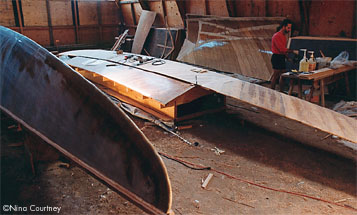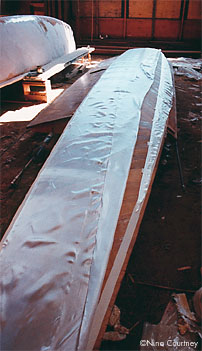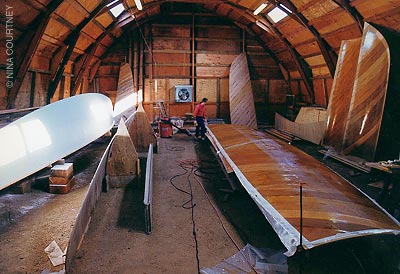
 |
||||||||||
|
While all the panels were being made (the centerboard and rudder too) in the carport, we set about building the barn. I haven't included photos of this adventure, but it was a real old-fashioned barn-raising for the ribs with a fair number of burly guys and attentive gals making it all possible.
We were able to acquire a large quantity of unwanted lumber from a local yard for about $300 a load. I had a general idea of what each truck would bring, but 3 loads were enough to fill up my available space. I took inventory of all various items, and then set out to design and build a barn and shop. |
||||||||||
 |
||||||||||
|
When the barn was complete, I called a few friends and we carried the very heavy mold inside for the next step- assembly of the hullsides. The mold serves as the support and stage for the joining of panels, which are butt-jointed and taped with 9-ounce biaxial fiberglass cloth. Above, one ama is assembled in the foreground while the other's starboard hull is being put together. The main hull (called a "vaka") panels, all coated with epoxy, await their turn against the wall. After the hull is assembled, I use gravity to assist in sheathing it with fiberglass cloth...
In the photo on the right, two layers of 4-ounce cloth are laid on below the waterline, with another layer overall. This is to provide protection from abrasion and adds some stiffness. This is then float-coated with epoxy, cured and sanded, ready for epoxy barrier coat primer. This is an starboard ama (or pontoon) hullside. Another (the portside) ama is already assembled off to the left. The ama hulls are basically stitched together with wire at the bow and stern while over over a set of frames placed at specified stations. One person can accomplish this with relative ease. We are anxiously watching Rikki-tikki-tavi take shape! So far, the building has progressed rapidly and smoothly. I have been very pleased with the Constant Camber® method and recommend it highly. I am building basically alone, with my wife's wholehearted encouragement. The support of one's family is of great importance to a boatbuilder with a passion. I've wanted to build a boat since I was seven with no opportunity until I met my second wife. Her parents sailed a Catalina 25, moved up to a Catalina 30, then found their dream boat- a 40-foot (plus bowsprit) Cheoy Lee center cockpit ketch. Much earlier, her grandparents had a boat designed and built for them. That sailboat became a popular design called "Serendipity", after their boat's christened name. They retired to this custom 37-foot motorsailer in British Columbia back in the early 1960's. It was in my love's heart... that spirit of adventure! |
||||||||||
 |
||||||||||
| This is a good overview of the panels and how I kept several steps going on at once. The port ama is pretty much finished with a coat of primer. The starboard ama is half assembled while I sheath one of the main vaka sides with four ounce fiberglass cloth. The panels against the wall have already received their two coats of epoxy on their interiors. The lighter, dull panels have yet to be sheathed, but they are sanded smooth. | ||||||||||
|
|
||||||||||
This site, copy and photographs copyright Nina Courtney.